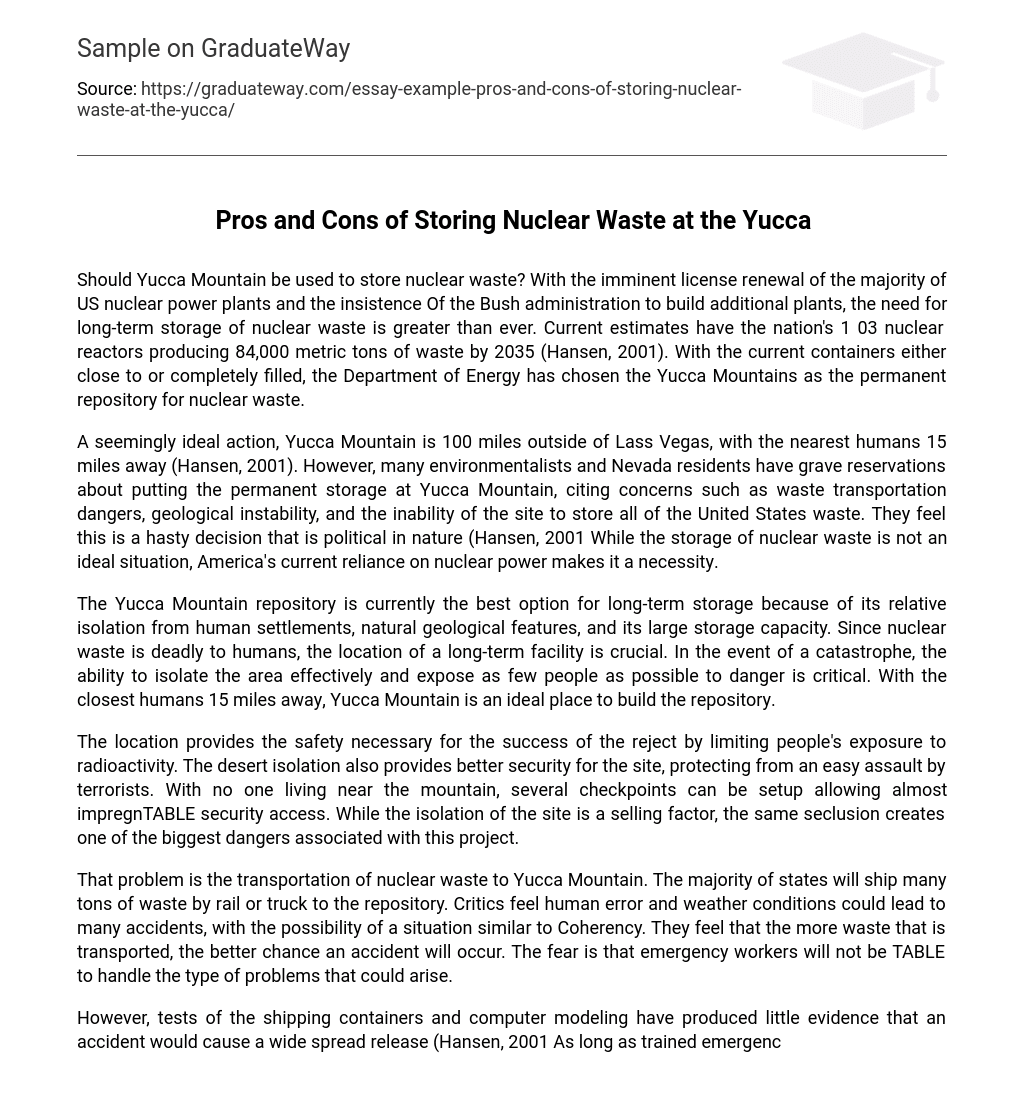Should Yucca Mountain be designated as a long-term storage site for nuclear waste? The need for such storage has increased due to the upcoming license renewals for most US nuclear power plants and the Bush administration’s plans to build more plants. Hansen (2001) predicts that by 2035, the 103 nuclear reactors in the country will produce 84,000 metric tons of waste. Because the current containers are almost full, the Department of Energy has chosen Yucca Mountains as the permanent facility for storing this waste.
A potential solution, Yucca Mountain, located 100 miles outside Lass Vegas, is considered an apparently ideal option (Hansen, 2001). Nevertheless, numerous environmentalists and Nevada residents express serious reservations about establishing permanent storage at Yucca Mountain. Their concerns stem from issues such as the dangers associated with waste transportation, geological instability, and the site’s inadequate capacity to store all of the United States’ waste. They argue that this decision is hastily made and driven by political motives (Hansen, 2001). Despite nuclear waste storage being far from ideal, America’s current reliance on nuclear power renders it a necessity.
The Yucca Mountain repository is the best option for long-term storage due to its isolation from human settlements, natural geological features, and its large storage capacity. The location of a long-term facility is crucial to ensure human safety as nuclear waste is lethal. In the event of a catastrophe, it is critical to effectively isolate the area and minimize exposure to danger for as few people as possible. With the closest humans located 15 miles away, Yucca Mountain proves to be an ideal site for constructing the repository.
The location offers the necessary safety for the success of the reject by restricting individuals’ exposure to radioactivity. Additionally, the desert isolation provides enhanced security for the site, guarding against potential terrorist attacks. Due to the absence of nearby residents, multiple checkpoints can be established, ensuring highly secure access. Although the site’s isolation is an attractive aspect, it also poses one of the project’s major dangers.
Transportation of nuclear waste to Yucca Mountain is a significant issue. Numerous states will use rail or truck to ship large amounts of waste to the repository. Critics argue that accidents could happen due to human error or adverse weather conditions, potentially resulting in a situation like Coherency. They believe that increasing the amount of waste transported also increases the likelihood of accidents occurring.
Tests of shipping containers and computer modeling have not found much evidence that an accident would cause a widespread release (Hansen, 2001). The rewards of the site far outweigh the risks as long as trained emergency workers can effectively handle potential dangerous situations. The Department of Energy plan involves selecting a site with natural geological features that, when combined with human barriers, would create a safe storage facility for the waste. Yucca Mountain meets this requirement, as stated in a 1998 study.
The Department of Energy report, citing Hansen (2001), explained that analyzing 15 years of site data indicated that the arid climate and stable geology would minimize the likelihood of a leak. Additionally, any leakage would need to traverse 1000 feet of rock before reaching the water level. The report further stated that once properly sealed, there would be negligible radiation exposure increase for 10,000 years (Hansen, 2001). Nevertheless, critics such as Novena’s Agency for Nuclear Projects challenge the study’s conclusions.
Citing other geological reports, Novena’s Agency for Nuclear Projects asserts that Yucca Mountain is situated in an earthquake zone and has encountered more than 600 occurrences of seismic activity measuring 2.5 or greater on the Richter scale (as cited in Hansen, 2001). The worry is that these seismic activities may result in tank ruptures and subsequent leaks. Nevertheless, the Department of Energy expresses confidence in the containers’ ability to withstand earthquakes and remain undamaged for a period of 10,000 years.
Despite the occurrence, the sites’ isolation will minimize the potential danger. Moreover, Yucca Mountain is deemed an ideal choice because of its ample storage capacity. According to Hansen (2001), it is anticipated that 84,000 metric tons of waste will require storage by 2035. Furthermore, the facility’s size enables it to serve as a test site for pioneering technologies like transmutation that could be utilized in future storage sites.
Transmutation, the process of extracting plutonium to reduce the radioactivity of nuclear waste according to the National Research Council, can greatly decrease isolation times (Hansen, 2001). The resulting product is safer and can be stored in closer proximity to humans. However, a significant drawback is its cost which was estimated at $280 billion in a 1999 Department of Energy study (as cited in Hansen, 2001). Nevertheless, the increased energy production resulting from transmutation will balance out this expense.
The 1999 Department of Energy study, as cited in Hansen (2001), found that it would take 117 years to transmute the current American nuclear waste. Nevertheless, ongoing research aims to enhance efficiency and reduce costs for safer storage in the future. Nuclear energy is crucial for our electricity production; however, careful consideration is necessary for the safe storage of nuclear waste. It is imperative to have a secure location with multiple natural barriers.
Yucca Mountain appears to be the most suitable choice for a repository, although critics argue that transportation runs increase the risk of a major leak. However, the containers used for shipping the waste are designed to prevent such incidents. Critics also express concern over potential dangers to the inhabitants of the region in case of any leakage. Nonetheless, the nearest population to Yucca Mountain is located 15 miles away. Additionally, the deep rock formation at the site will ensure that radioactivity does not contaminate water levels, and the mountain’s location will make it easier to protect the facility from terrorist threats.





